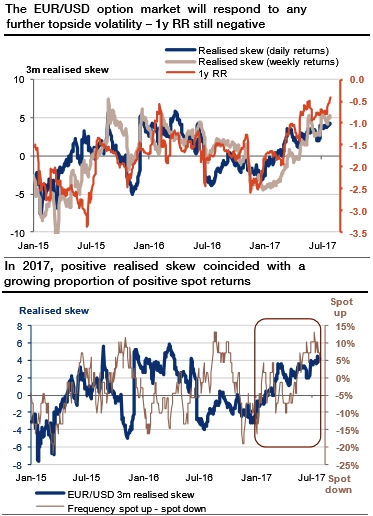We’ve stated in our recent posts about euro positive skewness. But the options skew reflects the relative appetite for calls and puts, which only partly reflects pure directional expectations. The skew is primarily about volatility expectations conditional on a scenario on the spot. The sensitivity and focus on reassessing central bank policy, and the ongoing vulnerability of the dollar. The theme of Europe leading outperformance remains dominant; maintain core EUR or proxy longs as data continue to be supportive, but increase USD shorts.
Market makers essentially trade the skew as per their perception of topside compared with downside volatility. To this end, we computed a realized skew that can be used like realized volatility. Namely, we computed the spread between two exponentially weighted realized volatilities, based on positive and negative returns (refer above chart). Dollar weakness continues to preserve prevailing vol themes of gamma strength, curve flattening and risk-reversal softness.
When the realized skew is positive, it shows that the FX rate experiences more topside than downside volatility. As expected, this metric is strongly correlated to the risk reversal. One could argue that using daily returns only captures market nervousness or noise, instead of meaningful spot moves.
So we also computed the realized with weekly returns instead of daily returns, and observe that our realized skew is relatively insensitive to the returns frequency. If we zoom in on the recent period, the EURUSD daily realized skew switched to positive territory in early March, while the weekly realized skew made this move at end-April. This fits with the EURUSD break of 1.08 right after the first round of the French presidential election.
Societe Generale reckons that the options market should respond to further topside vol:
Even if it has not always been true, the rise in the realized skew observed in 2017 happened on the back of a growing proportion of EURUSD positive returns (refer above chart). If EURUSD vol rises from limbo as the spot overshoots upwards, risk reversals should exhibit more bullishness.
As we have emphasized, the ECB still has to clarify how the QE process will reverse. The 2015-17 EURUSD range corresponded to its asset purchase period, and, more globally, the negative skew period (since 2009) corresponded to global central banks’ accommodation. As the market is still awaiting the next steps from the ECB and Fed, the full positive impact on the EURUSD skew is probably yet to be seen.



 Low pay and few contracts make freelance journalism a bleak prospect in 2024
Low pay and few contracts make freelance journalism a bleak prospect in 2024  South Korean President Yoon faces foreign policy challenges after the National Assembly election
South Korean President Yoon faces foreign policy challenges after the National Assembly election  Bitcoin is halving again – what does that mean for the cryptocurrency and the market?
Bitcoin is halving again – what does that mean for the cryptocurrency and the market?  The yen plunges to 34-year low despite interest rate hike
The yen plunges to 34-year low despite interest rate hike  An Israeli attack on Iran’s nuclear weapons programme is unlikely – here’s why
An Israeli attack on Iran’s nuclear weapons programme is unlikely – here’s why  If central banks don't start cutting them soon, it could actually increase inflation
If central banks don't start cutting them soon, it could actually increase inflation  Will the RBA raise rates again? Unless prices surge over summer, it's looking less likely
Will the RBA raise rates again? Unless prices surge over summer, it's looking less likely  China’s new world order: looking for clues from Xi’s recent meetings with foreign leaders
China’s new world order: looking for clues from Xi’s recent meetings with foreign leaders  What if the Reserve Bank itself has been feeding inflation? An economist explains
What if the Reserve Bank itself has been feeding inflation? An economist explains  Sure, the RBA froze interest rates on Tuesday, but there's plenty of pain to come
Sure, the RBA froze interest rates on Tuesday, but there's plenty of pain to come  FxWirePro- Gold Daily Outlook
FxWirePro- Gold Daily Outlook  Bank of England interest rate rise: why this could be the last increase for a while
Bank of England interest rate rise: why this could be the last increase for a while 































